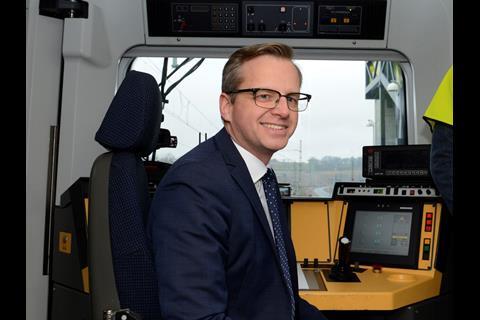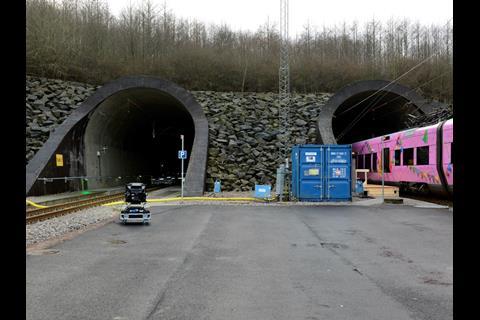SWEDEN: The country’s longest railway tunnel was officially inaugurated on December 8, when Minister of Enterprise Mikael Damberg drove a special train carrying VIPs through the 8·7 km Hallandsås Tunnel, before participating in an opening ceremony at the northern portal.
He was joined for the inauguration by the mayor of Båstad Bo Wendt, Governor of Skåne Margareta Pålsson, Trafikverket Director General Lena Erixon and project manager Botond Orban from DG Move’s Innovations & Networks Executive Agency.
The twin-bore tunnel is part of a project to eliminate one of the remaining single-track bottlenecks on the West Coast trunk line between Göteborg and Malmö, replacing a steeply-graded route over the Hallandsås ridge. Costed at SKr10·8bn (in 2008 prices), the work has been co-financed by the EU as part of the Trans-European Transport Network. Completion of the second track will boost capacity from four to 24 trains/h, while the easier gradients will permit heavier trailing loads for freight trains using the route.
As well as the tunnel itself, the double-tracking scheme has seen the construction of three new stations: Båstad to the north of the ridge and Barkåkra and Förslöv to the south. The latter two are to be served by an extension of Skånetrafiken’s Pågatåg regional services from the timetable change on December 13, which will see the number of passenger trains using the line double from 50 to 100 per day.
‘A well-functioning West Coast line is a vital link for both domestic and international transport. This tunnel will allow for many more trains, and with the three new stations will contribute to regional development in northern Skåne and southern Halland’, said Damberg.
Banverket and Skanska began construction of the tunnel in 1992, but work was stopped in 1997 after chemicals used for ground stabilisation polluted nearby watercourses. Around a third of the tunnel had been excavated at that stage. Construction resumed in 2003 using new techniques. Trafikverket says the ‘unfortunate’ incident was a ‘wake-up call for the industry’, which provided important lessons for the management of major projects.




















